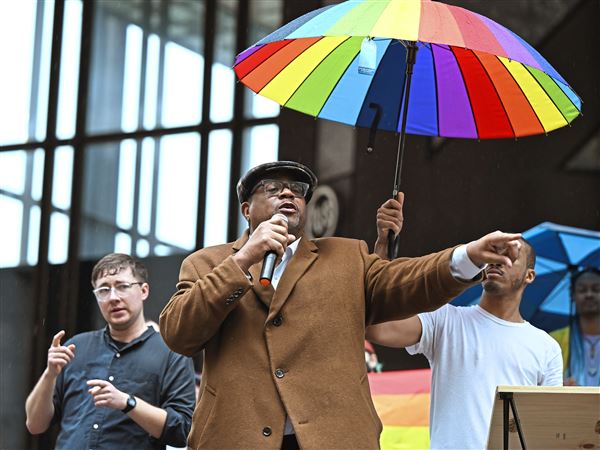The preliminary 2024 city budget and five-year plan proposed by Mayor Ed Gainey appears on its surface to be fiscally prudent. The plan takes into account a significant increase in debt service payments in 2025 and 2026, combined with the end of federal American Rescue Plan Act (ARPA) subsidies, while maintaining the balanced budget and reserve fund required under city law.
The footnotes, however, cast doubt on the city’s financial stability: Mr. Gainey’s budget assumes that negotiations with unions representing over 1,200 city employees will result in 0% raises in 2024. This is not honest. In fact, using more accurate assumptions about coming raises, the budget really projects deficits in 2025 and 2026 — nearly enough to put the city back under Act 47 state oversight — and reserves that will dwindle below the legal limit in 2026 or 2027.
All in all, keeping the coming raises off the budget hides between $25 million and $70 million in expenditures over the next five years.
Dishonest accounting
Unlike the federal government, the City of Pittsburgh is bound by law to maintain fiscal responsibility. Two primary safeguards are the requirement to keep reserve funds of at least 10% of annual expenditures and to never spend more in a year than the city takes in.
Further, to ensure long-term thinking, all city operating budgets must include a five-year plan. It is typical for the last years of the plan to drain reserves to near the 10% minimum, as mayors front load their proposals to maximize their political impact.
Mr. Gainey’s budget leaves reserves of about $72 million, or 10.2% of planned expenditures, at the end of 2028. It does so by ignoring the increased spending that will come through negotiations with firefighters, paramedics and the Pittsburgh Joint Collective Bargaining Committee, which represents laborers and other skilled workers.
In every department budget that includes these employees, the same footnote appears, indicating the 2024 plan assumes a 0% raise, and that the city expects the figures to change.
This is not standard practice. For instance, the 2019 preliminary budget submitted by former Mayor Bill Peduto during firefighter negotiations projected raises. And last year, while the city was in negotiations with the Fraternal Order of Police, the budget projected 2% bumps for officers — an estimate that proved to be much too low.
Even a small raise, spread across nearly 1,250 workers, adds up quickly. More than that, the raised wage becomes the new baseline for future wages, compounding the increase — and the amount of money Mr. Gainey’s budget doesn’t account for.
Deficits on the horizon
The 2023 police contract shows just how much a new deal can affect the city’s bottom line — and gives leverage to unions in this year’s negotiations. After coughing up so much cash for cops, it will be hard to plead poverty to firefighters, paramedics and other workers.
For 2023, most police officers received a raise of 9.67%. The agreement also includes raises of 3% each of the next two years.
If the roughly 1,250 workers currently in negotiations receive a similar deal — 9.67% in year one and 3% thereafter — that would amount to additional expenditures of nearly $70 million over the next five years. If this came to pass, based on Mr. Gainey’s proposal, not only would the city’s reserves dip below the legal limit in 2026: They’d be nearly exhausted by the end of 2028.
But it’s probably safe to assume the unique recruitment issues for police led to a one-year boost other unions won’t match. So let’s take a more modest raise of 3% annually for 5 years. Under that scenario, the city is still hiding $40 million in spending over the next four years — also enough to drain reserves below 10% in 2026, and to put the city in the red in 2025 and 2026. It takes three years of deficits to trigger Act 47 oversight.
Pittsburgh spent nearly 15 years under Act 47, from late 2003 to early 2018, during which the city had to comply with state-imposed restrictions on its financial independence.
One final complication: Mr. Gainey’s budget does include some increases in personnel spending in the relevant departments after 2024, though it’s not stated how much of that, if any of it, is meant to account for union raises. Even so, if those increases were applied equally to the 1,250 workers in question, they would only account for about $15 million over the next five years. That still leaves at least $25 million unaccounted for in the budget plan.
Once again, this is enough to result in two years of deficits, and illegally low reserves in 2027.
Answers needed
By assuming 0% union raises in 2024, Mr. Gainey’s budget is hiding expenditures the city will have to make. The plan makes promises the Mayor and his team must know they can’t keep.
Which raises the question: What is the real plan? Is it to try to make it all work and risk Act 47 status once again? Is it to lay off city workers once ARPA money runs out in 2024 and a second term in office is secured in 2025? Is it simply to cut planned spending the administration never really intended to make?
These are questions the public should ask of the Mayor’s Office during upcoming budget feedback meetings, including tonight in the Hill District. And these are questions City Council must get answers to before signing off on the budget in December.
Because, right now, the preliminary budget is not an honest proposal. The people of Pittsburgh, and their representatives on City Council, cannot allow themselves to be led blindly into financial instability.
First Published: October 12, 2023, 9:30 a.m.

















